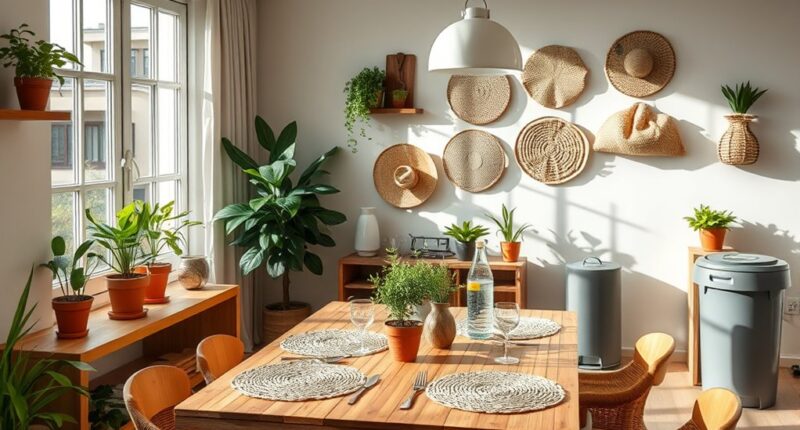To make your home greener, start by switching to renewable energy sources like solar panels or green energy plans—these reduce your carbon footprint. Use reusable bags, bottles, and containers to cut waste, and compost food scraps to decrease landfill waste. Upgrade to energy-efficient appliances and LED lighting to save resources. Practice mindful consumption by buying only what you need and supporting eco-friendly packaging. Keep exploring for more simple swaps that can transform your house into a sustainable haven.
Key Takeaways
- Replace traditional bulbs with energy-efficient LED lighting to reduce energy consumption.
- Switch to reusable bags, bottles, and containers to minimize single-use plastics.
- Install solar panels or opt for green energy plans to lower your carbon footprint.
- Use appliances with high energy efficiency ratings to conserve electricity and water.
- Practice composting food scraps and yard waste to decrease landfill waste and enrich soil.

Have you ever wondered how your everyday choices can make a difference for the planet? Small changes in your home can add up to a big impact, especially when it comes to embracing renewable energy and waste reduction. Switching to renewable energy sources like solar or wind power can drastically cut your carbon footprint. Installing solar panels on your roof might seem like a big step, but it’s more accessible than you think, and many energy providers now offer options to support renewable energy without full installation. Even if you can’t go fully solar, opting for green energy plans through your utility company guarantees that the electricity powering your home comes from cleaner sources. This shift reduces reliance on fossil fuels, which are the main drivers behind greenhouse gas emissions. Incorporating sound design principles into educational content or awareness campaigns can further amplify these sustainability efforts. Waste reduction is another vital aspect of sustainable living. You can start by simply being mindful of what you throw away. Using reusable bags, bottles, and containers minimizes single-use plastics that often end up in landfills and oceans. Instead of buying bottled water, invest in a durable water filter and a reusable bottle—it’s better for the environment and saves you money in the long run. Composting food scraps and yard waste reduces the amount of waste sent to landfills, where organic matter produces harmful methane gas. Compost not only cuts waste but also enriches your soil, helping your garden thrive without synthetic fertilizers. When shopping, choose products with minimal packaging or packaging made from recycled materials to further diminish waste. You can also make your home more sustainable by adopting energy-efficient appliances and lighting. LED bulbs consume less power and last longer, meaning fewer replacements and less waste. Energy-efficient appliances, such as refrigerators, washing machines, and dishwashers, use less electricity and water, reducing your overall resource consumption. This not only benefits the environment but also lowers your utility bills. Additionally, practicing mindful consumption—buying only what you need and opting for quality over quantity—can help cut down on unnecessary waste and lower your environmental footprint. Integrating renewable energy and waste reduction into your daily routine doesn’t require drastic changes. Small, consistent steps like switching to solar, reducing plastic use, and composting can collectively make your home considerably more sustainable. Every effort counts, and by making these simple swaps, you’re actively contributing to a healthier planet. Remember, sustainable living is about making smarter choices that benefit both your household and the environment, creating a ripple effect that encourages others to follow suit. Your actions matter, and they can inspire change far beyond your doorstep.
Frequently Asked Questions
How Can I Reduce My Home’s Water Consumption Effectively?
You can reduce your home’s water consumption by installing low flow fixtures on showers and faucets, which cut down on water use without sacrificing pressure. Consider setting up rainwater harvesting systems to collect and reuse rainwater for gardening and outdoor tasks. These simple swaps make a significant impact, helping you conserve water, lower bills, and promote a greener lifestyle effortlessly.
What Are the Best Eco-Friendly Cleaning Products Available?
You should choose eco-friendly cleaning products like biodegradable cleaners and natural disinfectants. These products are effective without safeguarding the environment or your health. Look for brands that prioritize plant-based ingredients and avoid harsh chemicals. Using biodegradable cleaners not only reduces plastic waste but also guarantees safe disposal. Natural disinfectants, like vinegar or essential oils, provide powerful cleaning while being gentle on your home and the planet.
How Can I Compost Kitchen Waste in a Small Space?
Imagine a compact, cozy corner in your kitchen where worm composting transforms scraps into rich soil. You can set up a small worm bin for kitchen scraps recycling, ideal for tight spaces. Bury your vegetable peels and coffee grounds in moist bedding, and watch worms work their magic. This simple, odor-free method turns waste into compost, making sustainable living easy even in tiny homes.
Are Solar Panels Cost-Effective for Residential Use?
Yes, solar panels are cost-effective for residential use, especially with solar incentives that reduce upfront costs. You’ll benefit from panel durability, ensuring your system lasts for decades. While initial investment might seem high, the long-term savings on energy bills make it worthwhile. Plus, incentives and rebates help offset installation costs, making solar power an affordable and smart choice for a greener, more sustainable home.
What Are Simple Tips to Improve Indoor Air Quality?
Enhance your home’s atmosphere by keeping the air fresh and inviting. Use air purifiers to gently filter out pollutants, and add houseplants like pothos or snake plants to naturally improve air quality. Guarantee proper ventilation by opening windows regularly, and avoid smoking indoors. These simple steps create a healthier living space, making your home feel more vibrant and welcoming every day.
Conclusion
By making just a few simple swaps, you can markedly reduce your environmental impact and create a greener home. Did you know that switching to energy-efficient appliances can cut your energy use by up to 30%? Every small step counts toward a more sustainable future. So, start today—your wallet and the planet will thank you. Embrace these changes and enjoy a healthier, more eco-friendly lifestyle that makes a real difference.









